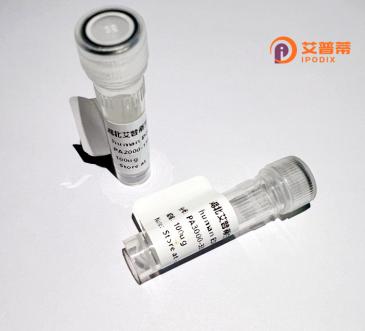
| 纯度 | >90%SDS-PAGE. |
| 种属 | Human |
| 靶点 | MYO9A |
| Uniprot No | B2RTY4 |
| 内毒素 | < 0.01EU/μg |
| 表达宿主 | E.coli |
| 表达区间 | 1-729 aa |
| 活性数据 | MNINDGGRRRFEDNEHTLRIYPGAISEGTIYCPIPAKKNSTAAEVIESLINKLHLDKTKCYVLAEVKEFGGEEWILNPTDCPVQRMMLWPRMALENRLSGEDYRFLLREKNLDGSIHYGSLQSWLRVTEERRRMMERGFLPQPQQKDFDDLCSLPDLNEKTLLENLRNRFKHEKIYTYVGSILIVINPFKFLPIYNPKYVKMYDNHQLGKLEPHIYAVADVAYHAMLQRKKNQCIVISGESGSGKTQSTNFLIHHLTALSQKGFASGVEQIILGAGPVLEAFGNAKTAHNNNSSRFGKFIQVNYQETGTVLGAYVEKYLLEKSRLVYQEHNERNYHVFYYLLAGASEDERSAFHLKQPEEYHYLNQITKKPLRQSWDDYCYDSEPDCFTVEGEDLRHDFERLQLAMEMVGFLPKTRRQIFSLLSAILHLGNICYKKKTYRDDSIDICNPEVLPIVSELLEVKEEMLFEALVTRKTVTVGEKLILPYKLAEAVTVRNSMAKSLYSALFDWIVFRINHALLNSKDLEHNTKTLSIGVLDIFGFEDYENNSFEQFCINFANERLQHYFNQHIFKLEQEEYRTEGISWHNIDYIDNTCCINLISKKPTGLLHLLDEESNFPQATNQTLLDKFKHQHEDNSYIEFPAVMEPAFIIKHYAGKVKYGVKDFREKNTDHMRPDIVALLRSSKNAFISGMIGIDPVAVFRWAILRAFFRAMVAFREAGKRNIHRKTGK |
| 分子量 | 111.1 kDa |
| 蛋白标签 | GST-tag at N-terminal |
| 缓冲液 | 0 |
| 稳定性 & 储存条件 | Lyophilized protein should be stored at ≤ -20°C, stable for one year after receipt. Reconstituted protein solution can be stored at 2-8°C for 2-7 days. Aliquots of reconstituted samples are stable at ≤ -20°C for 3 months. |
| 复溶 | Always centrifuge tubes before opening.Do not mix by vortex or pipetting. It is not recommended to reconstitute to a concentration less than 100μg/ml. Dissolve the lyophilized protein in distilled water. Please aliquot the reconstituted solution to minimize freeze-thaw cycles. |
1. **《MYO9A缺陷导致先天性巨结肠症的机制研究》**
- 作者:Wang et al.
- 摘要:研究发现MYO9A基因突变与先天性巨结肠症(HSCR)相关。通过小鼠模型和体外细胞实验,揭示MYO9A蛋白通过调节Rho GTP酶活性,影响肠道神经嵴细胞的迁移和分化,其缺失导致肠神经系统发育异常。
2. **《MYO9A在细胞膜重塑和癌细胞侵袭中的作用》**
- 作者:Dumont et al.
- 摘要:该文献报道MYO9A蛋白通过其RhoGAP结构域调控细胞骨架动态,促进乳腺癌细胞膜伪足形成和侵袭转移。抑制MYO9A表达可显著降低癌细胞迁移能力,提示其作为潜在治疗靶点。
3. **《MYO9A调控T细胞免疫突触形成的功能研究》**
- 作者:Müller et al.
- 摘要:研究发现MYO9A在T细胞活化过程中特异性富集于免疫突触区域,通过调节肌动蛋白网络重组增强T细胞受体信号传导。缺失MYO9A的T细胞表现出抗原识别和杀伤功能缺陷。
4. **《MYO9A与神经元轴突导向及阿尔茨海默病的关联》**
- 作者:Lise et al.
- 摘要:研究显示MYO9A通过介导Semaphorin信号通路参与神经元轴突导向,其表达水平在阿尔茨海默病患者脑组织中显著降低,可能与tau蛋白异常磷酸化和神经退行性病变相关。
MYO9A, a member of the class IX myosin family, is an actin-based motor protein that combines mechanochemical motility with regulatory functions. Encoded by the MYO9A gene in humans, it is characterized by a unique molecular structure: an N-terminal motor domain that binds actin and hydrolyzes ATP to generate movement, followed by a long tail region containing a Rho-GTPase-activating protein (RhoGAP) domain. This dual functionality enables MYO9A to regulate actin cytoskeleton dynamics by both physically remodeling actin filaments and modulating Rho signaling pathways. Specifically, its RhoGAP activity targets RhoA, promoting the conversion of active RhoA-GTP to its inactive GDP-bound form, thereby suppressing RhoA-mediated actomyosin contractility.
MYO9A is broadly expressed in tissues, with notable roles in immune cells, epithelial cells, and neuronal cells. It facilitates cellular processes such as cell migration, membrane trafficking, and phagocytosis by coordinating actin cytoskeleton rearrangement. Studies link MYO9A dysfunction to pathological conditions, including neurodevelopmental disorders, autoimmune diseases, and cancer metastasis. For example, MYO9A deficiency in mice results in immune dysregulation and impaired intestinal barrier integrity. Its interaction with cellular adhesion molecules and endocytic regulators further underscores its importance in maintaining tissue homeostasis. Unlike other myosins, MYO9A exhibits processive movement along actin filaments, a feature enhanced by its ability to autoinhibit RhoGAP activity during motility. This intricate regulation positions MYO9A as a critical adaptor molecule bridging mechanical forces and biochemical signaling in cellular adaptation to microenvironmental cues.
×